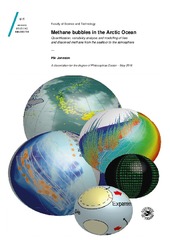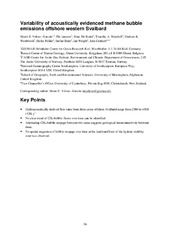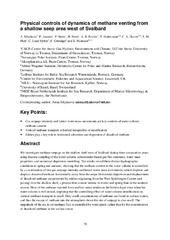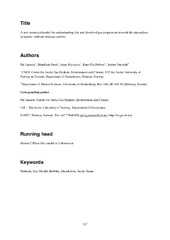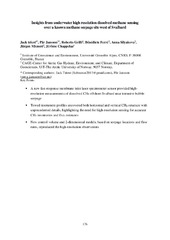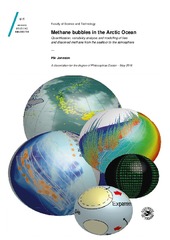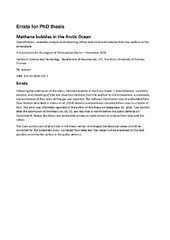| dc.contributor.advisor | Ferré, Bénédicte | |
| dc.contributor.author | Jansson, Pär | |
| dc.date.accessioned | 2019-01-18T12:17:37Z | |
| dc.date.available | 2019-01-18T12:17:37Z | |
| dc.date.issued | 2018-11-09 | |
| dc.description.abstract | Intensive but heterogeneous and transient seepage of methane (CH4) bubbles from the seafloor exist west of Prins Karls Forland (PKF), offshore western Svalbard. The powerful greenhouse gas CH4, has 32 times higher warming potential than carbon dioxide (CO2) and if seepage of CH4 from the seafloor reaches the atmosphere, it will contribute to the warming climate. Warming of the oceans may in turn, increase the release of CH4 to the water column, resulting in a positive feedback loop.
Repeated surveys using an underwater acoustic remote sensing method for the quantification of benthic gas emissions suggest that the seepage west of PKF is modulated by transient opening of gas migration pathways in the sediments. We performed a three-fold repetition of a 64-station oceanographic survey grid with water sampling and simultaneous echosounding. The observations, together with numerical experiments using Lagrangian drifters, showed that that the fate of the emitted methane depends on both the seepage intensity and the temporal dispersion efficiency. We developed a process-based 1-dimensional model resolving free and dissolved gas of several species and several bubble sizes. The model includes user-chosen parametrizations of bubble shapes, rising speeds, and transfer velocities and was designed for easy integration into large-scale ocean circulation models. High-resolution measurements, using a towed, newly developed membrane-inlet laser spectrometer revealed intensive seepage and rapid diffusion near a seepage location 30 km west of Prins Karls Forland, offshore western Svalbard. A new 2-dimensional advection- diffusion model based on hydroacoustically mapped seepage intensity and the vertical distribution predicted by the 1-dimensional model reproduced the observed patterns of dissolved methane along the tow lines in the area.
The research brings improved methods for quantification and upscaling of free gas flow rates, and modelling of free and dissolved gases in the water column. We anticipate that they will be used in future climate research, contributing to the understanding of the role of seafloor-emitted CH4 on ocean basin and global scales. | en_US |
| dc.description.doctoraltype | ph.d. | en_US |
| dc.description.popularabstract | The study quantifies methane gas bubbles released from the seafloor offshore western Svalbard. It investigates its variability by repeated surveys and suggests that seepage intensity depends on transient gas pathways.
Numerical ocean modelling, investigations of bubbling intensity and dissolved methane shows that concentrations depend on both seepage variation and dispersion patterns.
A process-based model for free and dissolved gas shows that bubble size is the most important factor for the vertical methane distribution. The model allows choices of bubble shapes, rising speeds and transfer velocities, and allows integration into ocean- and climate models.
High-resolution sensing revealed patchy methane distribution near seepage areas, suggesting strong emission and rapid diffusion, and was reproduced with a numerical 2-dimensional model.
The research brings tools for understanding the methane distribution around seepage areas, including an easy-to-use process-based model, suitable for large-scale ocean models. | en_US |
| dc.description.sponsorship | The research project was funded by UiT, through its Centre of Excellence funding scheme for CAGE, project number 22359. | en_US |
| dc.identifier.isbn | 978-82-8236-320-4 (trykt) og 978-82-8236-321-1 (pdf) | |
| dc.identifier.uri | https://hdl.handle.net/10037/14485 | |
| dc.language.iso | eng | en_US |
| dc.publisher | UiT Norges arktiske universitet | en_US |
| dc.publisher | UiT The Arctic University of Norway | en_US |
| dc.relation.haspart | <p>Paper I: Veloso-Alarcón, M.E., Jansson, P., De Batist, M., Minshull, T.A., Westbrook, G.K., Pälike, H. … Greinert, J. Variability of acoustically evidenced methane bubble emissions offshore western Svalbard. (Submitted manuscript). <p>
<p>Paper II: Silyakova, A., Jansson, P., Serov, P., Ferré, B., Pavlov, A.K., Hattermann, T. … Niemann, H. Physical controls of dynamics of methane venting from a shallow seep area west of Svalbard. (Submitted manuscript). <p>
<p>Paper III: Jansson, P., Ferré, B., Silyakova, A., Dølven, K.O. & Omstedt, A. A new numerical model for understanding free and dissolved gas progression towards the atmosphere in aquatic methane seepage systems. (Submitted manuscript). Published version in <i>Limnology and Oceanography: Methods</i>, is available at <a href= https://doi.org/10.1002/lom3.10307>https://doi.org/10.1002/lom3.10307. </a><p>
<p>Paper IV: Triest, J., Jansson, P., Grilli, R., Ferré, B., Silyakova, A., Mienert, J. & Chappellaz, J. Insights from underwater high resolution dissolved methane sensing over a known methane seepage site west of Svalbard. (Submitted manuscript).<p> | |
| dc.rights.accessRights | openAccess | en_US |
| dc.rights.holder | Copyright 2018 The Author(s) | |
| dc.rights.uri | https://creativecommons.org/licenses/by-nc-sa/3.0 | en_US |
| dc.rights | Attribution-NonCommercial-ShareAlike 3.0 Unported (CC BY-NC-SA 3.0) | en_US |
| dc.subject | VDP::Mathematics and natural science: 400::Geosciences: 450::Oceanography: 452 | en_US |
| dc.subject | VDP::Matematikk og Naturvitenskap: 400::Geofag: 450::Oseanografi: 452 | en_US |
| dc.title | Methane bubbles in the Arctic Ocean. Quantification, variability analysis and modelling of free
and dissolved methane from the seafloor to the atmosphere | en_US |
| dc.type | Doctoral thesis | en_US |
| dc.type | Doktorgradsavhandling | en_US |


 English
English norsk
norsk